
Autism
What is Autism?
Autism is a developmental disorder that impairs a person’s ability to interact and communicate. Autism impacts the neurological system, which affects the person's general cognitive, emotional, social and physical health. The range and severity of symptoms can vary widely, so Autism is often referred to as Autism Spectrum Disorder or ASD.
Some common symptoms of Autism include communication problems, social interaction problems, obsessional interests and repetitive behaviors. Autism is commonly detected before age two, and is about four times more likely in boys than in girls. Early detection as well as behavioral, educational and family therapies may help to reduce symptoms and promote growth and learning.
Autism continues to become more common. According to the United States Centers for Disease Control and Prevention website, in the year 2000 about 1 in 150 children were diagnosed with Autism. As of 2018 that number is 1 in 44 children.
Causes
The exact cause of Autism is not completely understood and research continues in an attempt to solve this puzzle. About 15% of Autism cases can be traced back to genetic issues/factors that when exposed to an immune activation event, such as a virus causing inflammation, can trigger an alteration to typical neurological development.
Research is also considering that there may be a correlation between the mother coming into contact with certain medications (valproic acid for example) or viruses (Influenza for example) during pregnancy, and the increased risk of the child developing Autism.
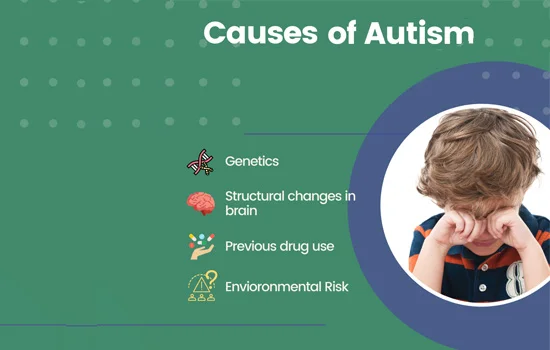
These factors seem to raise a child's risk of developing autism, but a higher risk is not the same as a cause. For instance, some gene alterations linked to autism can also be seen in individuals without the condition, and not everyone who is exposed to an environmental risk factor for autism will end up having the condition. Most won't.
According to research, autism frequently runs in families. Autism risk in children is increased by changes in specific genes. These gene alterations may be passed on to a child if one or more of the parents carries them (even if the parent does not have autism). Having these gene alterations does not ensure a child will develop autism, they just increase the risk. It is also important to note that not all gene alterations are inherited from parents, in some cases, the sperm or egg that combine to form the embryo experience these genetic alterations at the time of conception.
Autism.am has a great graphic illustrating all these various factors in one image.
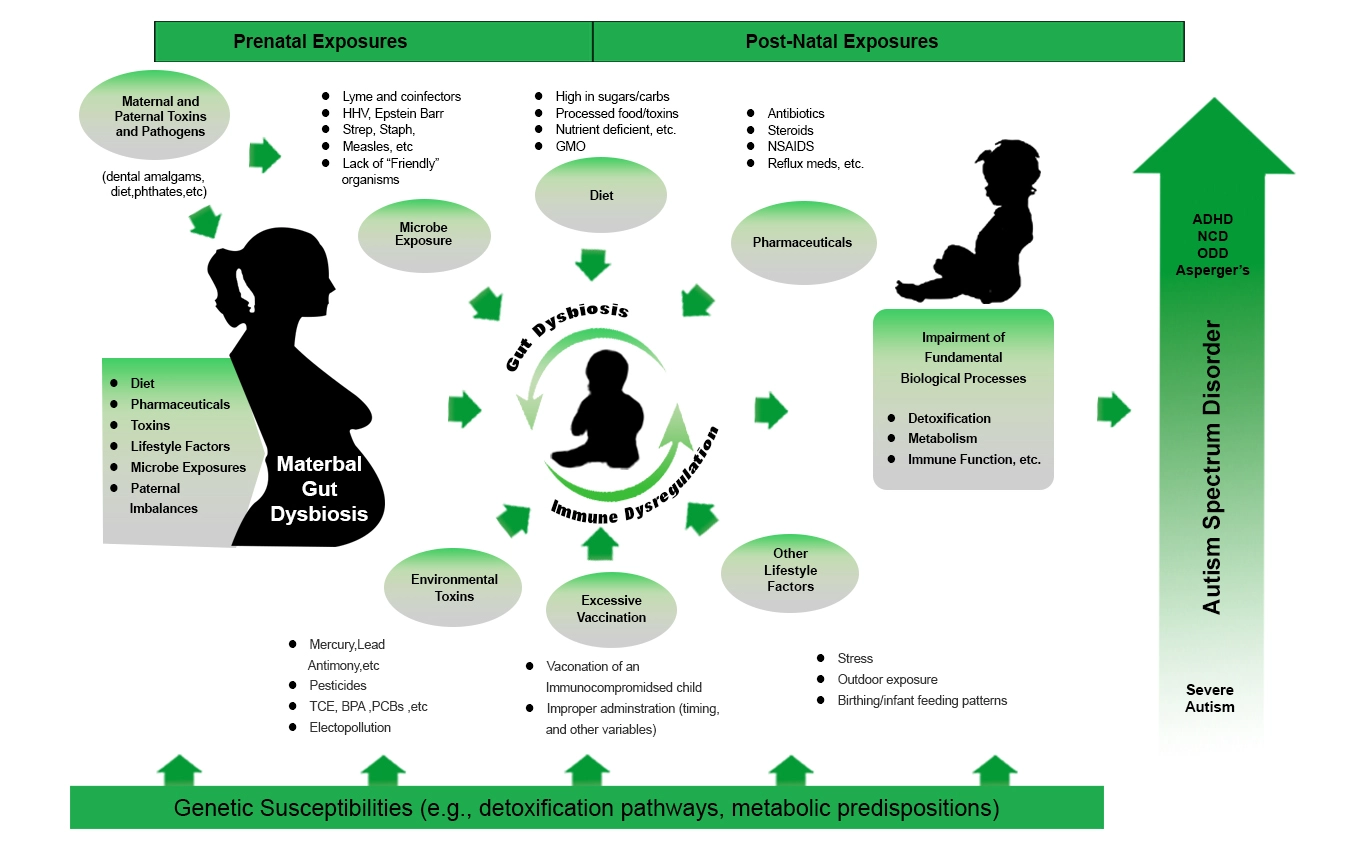
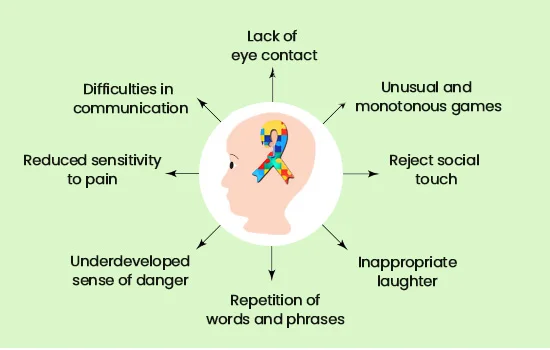
Symptoms
Symptoms of Autism such as lack of eye contact or loss of previously gained language skills typically appear by the age of two, but not in every case. As children with Autism age past two there can be divergence in intelligence with some showing below average intelligence and others having normal or high intelligence, but typically without the ability to apply everything they know to their daily lives.
There are some typical symptoms in people with Autism, again these vary widely and not every person with Autism will display all of them.
Interaction
-
Poor eye contact
Behavior
-
Restrictive diet choices
-
Performs self-stimulation activities such as arm flapping
It is common for children with Autism to develop speech impediments or have difficulty speaking at all, and the rate of language development varies from case to case. While some children with Autism have difficulty communicating with others about general topics, others may they find a certain subject to be highly interesting, they may grow a very robust vocabulary for discussing that particular subject.
Diagnosis
There is no specific medical test, such as a blood test, for the diagnosis of Autism. For this reason, doctors must rely on clinical evaluations, the child’s behavior and developmental history.
DSM-5, has laid out a series of requirements for a person to be diagnosed with ASD. This covers four areas, and the person must meet criteria in all four of them.
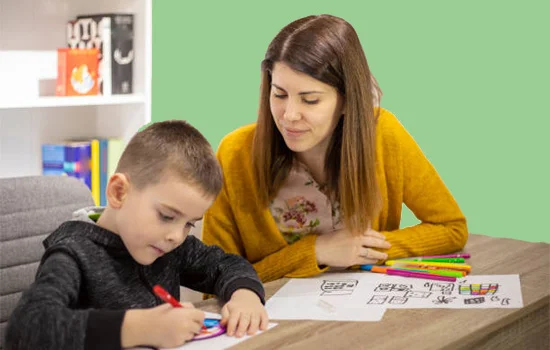
1 - Persistent deficiencies in social interaction and communication in a variety of circumstances (must meet all 3 of these)
Deficits in social-emotional reciprocity, such as typical social behavior and failure to engage in regular back-and-forth dialogue.
Deficits in nonverbal communication skills including things like eye contact, body language, gestures and facial expressions.
Deficits in creating, maintaining, and comprehending relationship connections, including, for instance, challenges in establishing friends, and lack of interest in peers.
2 - Restricted, recurring behaviour, passions, or pursuits, as demonstrated by at least two of the following (must meet 2 or more of these)
Repetitious or stereotypical speech, or movements, for example arm flapping or insistence on lining up toys.
Insistence on routines or patterns, sometimes seen as extreme difficulty dealing with changes in the normal daily schedule, or the requirement to eat the same food all the time.
Limited and fixated interests, for example a strong attachment to certain toys or objects.
Unusual sensitivity to sensory inputs, for example difficulty with certain textures, challenges with certain sounds, and indifference to pain or temperature.
3 - Symptoms must be present in early childhood
4 - Symptoms impair everyday functioning
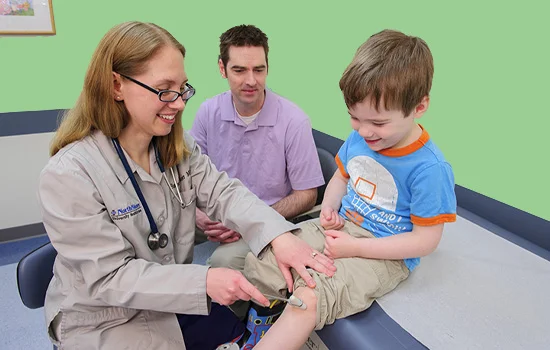
Treatment
Unfortunately, in ASD, the range of symptoms vary widely, so there is no single approach that works in all cases, and in some cases there is little improvement, but research has shown that early diagnosis and intervention is key to maximizing the potential for children with the disorder.
There are many therapy options, and each case is different, but some common therapies that tend to help include occupational, physical and speech therapy. In some cases music therapy has proven beneficial. Be sure to research the various therapy options available in your area when working on your Individual Education Plan with your child’s school.